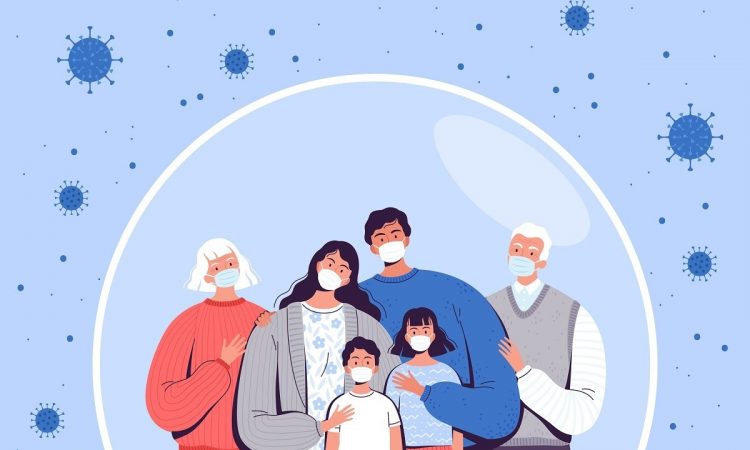In a recent study published in PNAS, researchers investigated whether prior exposure to coronaviruses (CoVs) induces cross-reactive immunity that protects adults from severe coronavirus disease 2019 (COVID-19).

Background
Epidemiological studies have consistently shown that prior exposure to non-severe acute respiratory syndrome coronavirus 2 (SARS-CoV-2) CoVs confers some resistance to SARS-CoV-2 infection and severe COVID-19. It is most likely due to the development of cross-reactive immunity in young children, but how this potential cross-immunity renders immunity against SARS-CoV-2 infection in adults remains poorly understood. Also, it remains unknown how effectively the elicited cross-reactive antibodies combat the SARS-CoV-2 infection.
About the study
In the present study, researchers leveraged data from integrated health care information systems, which link records of adults with their children to find evidence of cross-immunity in a large population sample. Based upon a COVID-19 propensity score and risk factors for severe COVID-19, they matched the study cohort of adults with children in the age group of zero to five years to adults with children six to 11 years (Comparator Group 1), 12–18 years (Comparator Group 2), and those without children (Comparator Group 3) in a 1:1 ratio.
The study population comprised ≥ 18-year-old adults who were active members of Kaiser Permanente Northern California (KPNC) healthcare delivery system. They also identified all children under 18 years subscribed to the same health insurance plan with each adult member between February 1, 2019, and January 31, 2021. The researchers also obtained patient demographics and comorbidities data before February 20, 2020 (index date) through health plan enrollment files and skimming through clinical, pharmacy, and laboratory databases.
The team calculated crude event rates and incidence rates per 100 person-years for each study outcome. Notably, they used two approaches to calculate the incidence rates for the study outcomes reflecting severe COVID-19 illness (e.g., hospitalization), as follows: i) as a proportion of all the members within the study subgroup, and 2) as a proportion of positive COVID-19 cases within the study subgroup. Based on Poisson rates, the team calculated comparative incidence rate ratios (IRRs) of the study group and three comparator groups.
Study findings
Based on the eligibility criteria, the researchers identified 3,126,427 adults, of which 24% had children under 18 years on their health insurance plan. Of these, 8.8%, 6.8%, 8.2%, and 76.2% had the youngest child between zero to five years, six to 11 years, 12 to 18 years, and no children, respectively. This data corresponded to 265,213, 205,744, 250,475, and 2,282,236 incidence rates person-years of follow-up.
While body mass index was similar across all study groups, severe COVID-19 risk factors, such as hypertension and diabetes, were higher among patients with older children. The propensity-matched study samples reflected 50% and 30% of the study population for Comparators 1 and 2, respectively. However, they reflected 95% of the study population for Comparator group 3.
In unadjusted analyses, the IRRs of COVID-19 infection were similar across study and comparator groups that had exposure to children regardless of age but were lower in adults without exposure to children (0.98 vs. 0.72). Conversely, the IRRs of COVID-19 infection requiring hospitalization and intensive care unit (ICU) admission was higher in all three comparator groups, regardless of the approach used. Propensity-matched analyses balanced the risk factors for severe COVID-19 illness. Accordingly, the IRRs of COVID-19 infection were slightly higher for adults with older children, but the authors observed no difference in rates of COVID-19 cases requiring hospitalization or ICU admission.
Conclusions
The study results demonstrated that prior exposure to CoVs other than SARS-CoV-2 was not associated with a reduction in SARS-CoV-2 infection rates but conferred protection against severe COVID-19 in adults who resided close to these young children. Moreover, COVID-19 hospitalization and ICU admission rates were 27% and 49% higher among those with no household exposure to young children. After balancing all the risk factors for severe COVID-19, the figures touched 49% increased risk of COVID-19-related hospitalization and up to 76% increased risk of COVID-19 cases requiring ICU admission.
The development of memory immunity and cross-immunity to families of viruses could explain some of the observed heterogeneity in the adverse COVID-19 outcomes. However, future research should use more detailed immunologic analyses to test for evidence of cross-immunity and examine the effects of occupational exposure to young children (e.g., teachers).
- Matthew D. Solomon, Gabriel J. Escobar, Yun Lu, David Schlessinger, Jonathan B. Steinman, Lawrence Steinman, Catherine Lee, Vincent X. Liu. (2022). Risk of severe COVID-19 infection among adults with prior exposure to children. PNAS. doi: https://doi.org/10.1073/pnas.2204141119 https://www.pnas.org/doi/10.1073/pnas.2204141119
Posted in: Medical Science News | Medical Research News | Disease/Infection News
Tags: Antibodies, Body Mass Index, Children, Coronavirus, Coronavirus Disease COVID-19, covid-19, Diabetes, Health Care, Health Insurance, Healthcare, immunity, Intensive Care, Laboratory, Pharmacy, Research, Respiratory, SARS, SARS-CoV-2, Severe Acute Respiratory, Severe Acute Respiratory Syndrome, Syndrome

Written by
Neha Mathur
Neha is a digital marketing professional based in Gurugram, India. She has a Master’s degree from the University of Rajasthan with a specialization in Biotechnology in 2008. She has experience in pre-clinical research as part of her research project in The Department of Toxicology at the prestigious Central Drug Research Institute (CDRI), Lucknow, India. She also holds a certification in C++ programming.
Source: Read Full Article
